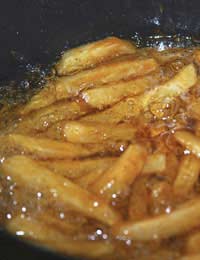Personal Safety in the Kitchen

How safe is your kitchen? Do you follow safety instructions by the book or is your approach more slap-dash? Take our quick Personal Safety quiz and determine the biggest hazards in your kitchen.
Has your Electrical Wiring been Serviced recently?
If you haven’t had your wiring checked recently you might be surprised at its state! New regulations demand professional circuitry, better fuse-boxes and proper casings for outdoor sockets. The kitchen is a real hotspot for electrical overload – toasters, kettles, blenders, coffee-makers and washing machines all need a socket! If you use an extension lead or load up sockets with two or three plugs, an electrician could quickly add some sockets to improve general safety.Do you use a Non-Electrical Deep Fat Fryer?
Eek! Deep-fat frying is one of the biggest causes of kitchen accidents. A ‘fat fire’ injures an estimated four people every day. This is because fat reaches very high temperatures and the high heat can quickly cause combustion. You only have to step away from the pan for a minute – turn up the radio or take some burgers from the freezer – for a fire to start.If your family eats a lot of chips, invest in a thermostatically-controlled fat fryer (£40-£50)– it will regulate its own temperature, which also avoids smoke. Alternatively, you could use your oven to bake chips. Oven fires are far less dangerous because, if they do start, they will be contained within the oven. If a fire begins in your deep fat fryer – and you are in the room to see it – then turn off the heat, and put a lid on the pan if possible.
Are your Matches and Chemicals out of Reach?
Matches, lighters, kitchen cleaners, and other toxic fluids should be kept well out of reach of children. RoSPA is campaigning for housing developers to incorporate a lockable kitchen cupboard in every new home they build. If your cupboards are all at foot level, fixing a lock to an existing cupboard is very easy.Has your Gas Oven or Boiler been Serviced this Year
Gas-burning appliances give out waste gases including carbon monoxide – which can be fatal in large doses. That’s why it is so important to have these appliances serviced. Your CORGI-registered supplier should check vents and pipes to ensure that waste gas is being distributed away from the room.You should keep an eye on these appliances, too: don’t let pilot lights go out, and make sure nothing is blocking vents or grilles (in other words, don’t cover them up with anything). Tip: The gas flame on your oven or hob should burn blue. If it’s burning orange, there could be a gas build-up – get it checked quick.


Re: Personal Safety Abroad
My gf found out I was flirting so to get revenge she tied me naked to a bed in a hotel then rang room service BTW it was my bday and she…
Re: Personal Safety Abroad
Stepfather raped me Six times Before he died When I He pulled my hair and dragged me into the house When I was talking to the staff at…
Re: Personal Safety Abroad
Stepfather raped me Six times Before he died When I He pulled my hair and dragged me into the house When I was talking to the staff at…
Re: What is Stranger Danger
Hi don’t like walking around town waking to swimming Alford
Re: The Role of Victim Support
What should I do if ,lets say I pay for the house which is on rent and then ,the landlord fails to vacate the house? You call him…
Re: Personal Safety on the Street: How Much Should I Worry?
None - Your Question:I have been unfairly cautioned by police after an attack.The man who…
Re: Personal Safety on the Street: How Much Should I Worry?
I have been unfairly cautioned by police after an attack.The man who punched me lied to…
Re: Personal Safety Abroad
Can I get justice for this even if the woman that destroyed me is dead and I have no proof of this because I never told anyone till now.So…
Re: Learning About Self Defence
I really find these articles very helpful as far as safety is concerned. I appreciate if more of such articles are sent to my mail…
Re: What is Stranger Danger
Some tips on how to keep your young ones safe: 1. If you do feel uncomfortable about somebody talking to you just kindly say. I promise…